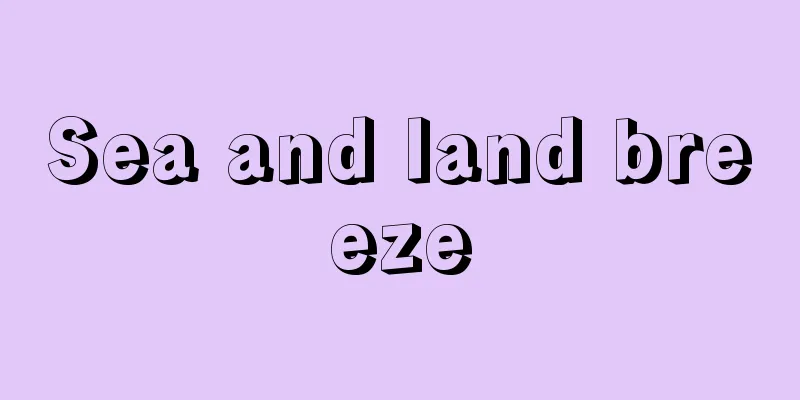Sea and land breeze

|
A type of local wind system whose direction reverses between day and night. It develops in coastal areas of tropical and temperate regions on clear days. During the day, it becomes a sea breeze blowing inland from the coast, and at night, it becomes a land breeze blowing from the inland to the ocean, but generally the sea breeze is more prominent, and in low latitudes it can exceed 10 meters per second. Sea and land breezes occur in areas where land and ocean meet, and the effects of daytime solar radiation and nighttime radiative cooling are different between the ocean and the inland, creating a temperature difference between the two regions, which causes the localized wind system to blow as a convective wind. In temperate regions, sea and land breezes blow mainly in spring, summer, and autumn, and are most pronounced in summer. In winter, sea breezes rarely blow unless it is a very sunny and warm day. Because the local wind changes are significant, some places give the sea and land breezes local names. For example, in the Catalonia region of northeastern Spain, the sea and land breezes are called Marinada. In tropical regions, sea and land breezes blow almost every day during the dry season. However, they weaken during the rainy season. Sea and land breezes generally develop well on sunny days. According to a study in Bulgaria, the frequency of occurrence is 90% when the cloud cover is between 0 and 5, 40% when the cloud cover increases to between 6 and 8, and 27% when the cloud cover is between 9 and 10. On sunny summer days, sea breezes penetrate about 40 kilometers inland. For example, in the southern Kanto region, sea breezes blow inland up to about 40 kilometers. Sea breezes in high latitudes often move inland in the form of fronts, and in the morning the sea breezes blow out later than in low latitudes, around 10:00 a.m. In Hokkaido and other areas, sea fog carries inland on the sea breezes. Sea and land breezes also develop over coral reefs in tropical oceans. When the sea breeze and land breeze alternate, there is a temporary calm, and this calm in the mornings and evenings is called a "calm." When the morning calm ends, the sea breeze starts at a height of several tens of meters, and gradually expands vertically and horizontally, reaching a height of over 1 kilometer at its peak. The air above it is a land breeze, but its wind speed is much weaker than that of the sea breeze on the surface. When the regular circulation of sea and land breezes is disrupted, it is a sign of deteriorating weather and is a point to pay attention to when observing the weather. [Nemoto Junkichi] [Reference] | |©Shogakukan "> Frontal sea breezes seen in high latitudes Source: Shogakukan Encyclopedia Nipponica About Encyclopedia Nipponica Information | Legend |
|
昼夜で風の方向が反転する局地的な風系の一種。晴天の日、熱帯および温帯地方の海岸地方で発達する。日中は海岸から内陸に吹き込む海風となり、夜間は内陸から海洋に吹き出す陸風となるが、一般に海風のほうが顕著で、低緯度地方では毎秒10メートルを超すこともある。海陸風は、陸地と海洋が接している地域で、日中の太陽放射と、夜間の放射冷却の影響が海洋と内陸で異なっているため、両地域に温度差が生じ、そのため局地的に対流性の風系として吹くことになるのである。 温帯地方では海陸風は主として春、夏、秋に吹き、夏がもっとも顕著で、冬はよほど晴天で暖かな日でないと海風はほとんど吹かない。局地的な風の変化が顕著なため、海陸風に局地的名称がつけられている所もある。たとえばスペイン北東部のカタルーニャ地方では海陸風をマリナダMarinadaとよんでいる。熱帯地方では、乾期にはほとんど毎日海陸風が吹いている。しかし雨期には弱くなる。 海陸風は一般に晴天の日によく発達する。ブルガリアで調べたところによると、雲量が0~5のときは出現頻度90%、雲が多くなり6~8になると40%となり、9~10で27%と少なくなっている。夏の晴天時、海風は内陸へおよそ40キロメートルほど侵入していく。たとえば関東地方南部では海風は内陸部へ40キロメートルあたりまで吹き込んでいる。 高緯度地方の海風は前線性の形をとって内陸に侵入していく場合が多く、午前中に海風の吹き出す時間は低緯度地方より遅れ、10時過ぎごろとなっている。北海道などでは、この海風にのって海霧が内陸部に侵入してくる。熱帯の海洋上のサンゴ礁の上にも海陸風は発達する。 海風と陸風の交替時、一時無風状態になるが、朝夕のこの無風時を凪(なぎ)という。朝方の凪が終わると、海風は、初め数十メートルの高さから、しだいに垂直方向と水平方向に拡大してゆき、海風の最盛時には海風の高さは1キロメートルを超す。その上空は陸風になっているが、その風速は地表の海風よりははるかに弱い。 規則的な海風、陸風の循環の乱れるときは、天気の崩れる前兆であり、観天望気の一つの注目点である。 [根本順吉] [参照項目] | |©Shogakukan"> 高緯度地方でみられる前線性の海風 出典 小学館 日本大百科全書(ニッポニカ)日本大百科全書(ニッポニカ)について 情報 | 凡例 |
<<: Hǎi Lù fēng sū wéi āi (English spelling)
Recommend
Kagashira - Kagashira
...There are over 200 species of the tropical Dip...
Sterigmatocystin
…In 1918, Miyake Ichiro isolated the yellow rice ...
al-Qahira (English spelling)
...Population: 6.85 million (1994). In Arabic, it...
Personal name system
The jinmyo system was seen in the Sanuki Shiwaku I...
König (English spelling)
…In the Byzantine Empire, basileus was used to me...
Moldovan - Moldovan (English spelling)
A Romance language with over 2 million speakers, m...
Ten Years of Suffering
= Kugai (public) ten years *Sakehon, Hanashi no Ga...
Akashi Park - Akashi Park
(Akashi City, Hyogo Prefecture) A tourist attracti...
Haining Chao - Kaining Chao
…The part of the river that transitions from the ...
Auntie -
〘Noun〙① One's wife's sister. Also, one'...
fairy primrose (English spelling) fairyprimrose
...In Japan, foreign-origin horticultural plants ...
Yu Woo Seok - Ryuusha
A poet from the mid-Tang period in China. His pen...
External nose
The part of the face that protrudes from the cente...
"Isemiyage Kawasaki Dance Beat" - Isemiyage Kawasaki Ondo
...Fukuoka Mitsugu is played by Nakayama Bunshich...
Usumbura - Usumbura
Former name of Bujumbura, the largest city in the ...
![Aki [city] - Aki](/upload/images/67cad1451cd7a.webp)








